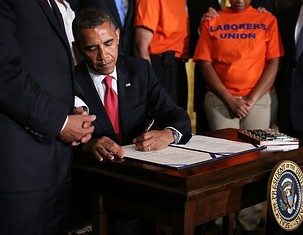What the New Transportation Bill Means for Company Truck Drivers

 Recently we reported that President Obama signed the Surface Transportation Bill into law, amid some political posturing and after some stop-gap measures that put thousands of construction, trucking and service jobs in the crossfire. A few lawsuits were filed, but the dust has finally cleared, giving way to boosts in infrastructure projects, port upgrades and truck driver hires.
Recently we reported that President Obama signed the Surface Transportation Bill into law, amid some political posturing and after some stop-gap measures that put thousands of construction, trucking and service jobs in the crossfire. A few lawsuits were filed, but the dust has finally cleared, giving way to boosts in infrastructure projects, port upgrades and truck driver hires.
Basically the bill provides billions in spending measures for states that are ailing from highway and bridge budget crunches. Overall, the bill should at least give state and local government transportation agencies the ability to plan for larger projects, because legislation maintains current highway funding until September 2014.
The bill will likely speed up construction of highway projects and increase financing leverage for private infrastructure work. Ports, however, saw their hopes of getting more money through the Harbor Maintenance Trust Fund dampened, as the bill took a softer stance than advocates wanted. Most truck companies will welcome the requirement that trucks have electronic onboard recording devices, while owner-operators will recoil at the additional costs for the technology.
Below is breakdown of the key freight-related policies in the transport bill:
Highway Construction
The bill aims to reduce by half the average highway construction time period of 15 years by streamlining environmental review. The number of federal highway programs would be cut by two-thirds to free up resources for states’ and cities’ highway projects. The bill increases accountability for highway projects with a greater focus on how the projects would reduce fatalities, ease congestion, improve freight movement and boost the economy. However, some transportation advocates say the bill doesn’t do enough to ensure infrastructure is maintained and a mulit-modal approach is taken.